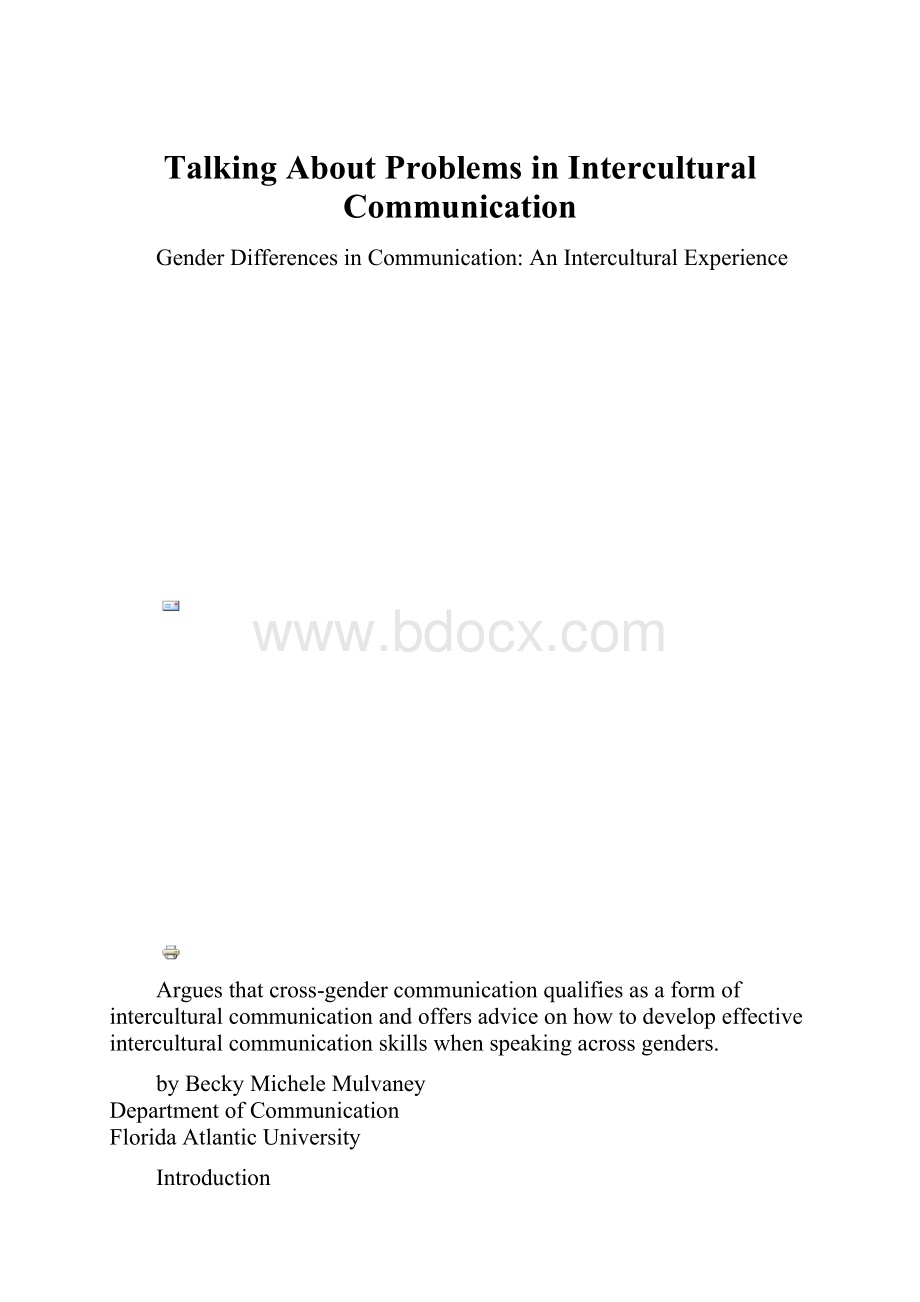Talking About Problems in Intercultural Communication.docx
《Talking About Problems in Intercultural Communication.docx》由会员分享,可在线阅读,更多相关《Talking About Problems in Intercultural Communication.docx(15页珍藏版)》请在冰豆网上搜索。

TalkingAboutProblemsinInterculturalCommunication
GenderDifferencesinCommunication:
AnInterculturalExperience
Arguesthatcross-gendercommunicationqualifiesasaformofinterculturalcommunicationandoffersadviceonhowtodevelopeffectiveinterculturalcommunicationskillswhenspeakingacrossgenders.
byBeckyMicheleMulvaney
DepartmentofCommunication
FloridaAtlanticUniversity
Introduction
AcatalogwhichrecentlyarrivedatmyhouseadvertisesT-shirtsandbumperstickerspopularizingthewordsoffeministscholarsCherisKramarae&PaulaTreichler:
"Feminismistheradicalnotionthatwomenarepeople."
(1)Indeed,sometimesIthinkwe'vespentthelasttwomillenniamakingthatnotionacceptable.Now,asthe20thcenturyends,wemaybeatthepointofcompletingafirststepforwomen--thatfirststephasbeenadifficult,long-termstruggletowardacceptanceofwomenaspeople.
Yethistorydemonstratesthatlegalpersonhooddoesnotnecessarilyresultincomparable/equaltreatment.Thatis,women,likesomanyothergroups,havegainedlegalrightsonlytofacelessinstitutional,perhapsmoresubtlebutinsidiousformsofdiscrimination.Inthistimewhenpolitical,educational,andsocialdiscussionscenteronissuesofdiversityandofcreatingaconstructive,multi-culturalsociety,itmaybehelpfultoexamineproblemsincommunicationbetweenthegendersasaculturalissue.Thisisnottheonly,theright,orthebestwayofexamininggenderandcommunication,butitdoesofferanalternativeframeworkforanalysis,onethatperhapsdefusesthepotentialforoffensiveand/ordefensiveposturingwhendiscussinggender.
Hence,inthispresentationIarguethatitisbothusefulandappropriatetoviewgendercommunicationasaformofinterculturalcommunication.First,Iofferabriefprimerongenderdifferencesincommunicationwithprimaryemphasisonexamplesthatillustratehowgenderisbothaninfluenceonandaproductofcommunication.Inshort,thisdiscussionhighlightstheprimaryroleplayedbycommunicationingenderissues.Second,IofferdescriptionsofsomesalientelementsofinterculturalcommunicationandIillustratehowgendercommunicationisaformofinterculturalcommunication.Finally,Iwillapplyadviceonhowtodevelopeffectiveinterculturalcommunicationskillstothesituationofgendercommunication.Duringourdiscussionperiod,Ihopethatyou,theaudience(thetrueexpertsongendercommunicationissuesandthelibrarian)willprovideexamplesofproblemsand/orpossiblesolutionsrelateddirectlytothepracticinglibrarian.OverviewonGenderandCommunication
Twoassumptionsfromcommunicationtheory(bothclassicalandcontemporarytheories)helpsituatemyoverviewongenderandcommunication.First,communicationisepistemic.Thatis,communicationisthemediumbywhichwecometoknowthings(Protagorasarguedthatabsolutetruthwasinaccessibletohumans;hence,truthhadtobeestablishedbyhumanstandards[doxa].Similarly,contemporaryrhetoricaltheoristsarguethattruthissociallyconstructedthroughlanguageandothersymbolsystems).
(2)Forexample,itwasthroughscientificdiscourse(rhetoric)thatpeoplecametoviewtheuniverseasearth-centered.HumanacceptanceofthisnarrativewassostrongthatGalileo,inpositingthattheuniverseissun-centered,wasplacedunderhousearrest.
Mysecondassumptionaboutcommunicationisthatitisaxiological.Thatis,communicationisvalue-laden.Virtuallyallcommunicationtheoristsagreethatlanguageissubjective.Allcommunicationmakesclaimsandtakesstances.Andsometheorists,suchasWeaver,Eubanks,andWinterowdwouldarguethatnolanguageisneutral.(3)Indeed,anyuseofcommunicationexhibitsanattitude,andanattitudeimpliesanact,andallhumanactionshavemoralconsequences.Hence,communicationentailsmoralrepsonsibility.
Thesignificanceofcommunicationpracticesinshapingourlivesisnolessimportantinthearenaofgenderandcommunication.Infact,LaurieArlissarguesthat"communicationisthoughttobe,atonce,theprocessbywhichwelearntobemaleorfemale,andtheproductofourattemptstobehavesexappropriately."(4)Indescribingfeministcriticism,rhetoricalcriticSonjaFosspositsthat"Itsfocusisonafundamentalelementofhumanlife--gender--anditisdramaticallychangingtheformandcontentofknowledgeaboutrhetoric."(5)Thatis,genderisbothaninfluenceonandaproductofcommunication.Letmeprovideafewillustrations.
Fromaveryearlyage,malesandfemalesaretaughtdifferentlinguisticpractices.Communicativebehaviorsthatareacceptableforboys,forexample,maybeconsideredcompletelyinappropriateforgirls.Hence,thebodyofresearchonwomenandlanguagerevealsthatwomenexperiencelinguisticdiscriminationintwoways:
inthewaytheyaretaughttouselanguage,andinthewaygenerallanguageusagetreatsthem.(6)So,forexample,womenreflecttheirroleinthesocialorderbyadoptinglinguisticpracticessuchasusingtagquestions,qualifiers,andfillerstosoftentheirmessages.Likewise,traditionallywomenwereidentifiedbytheirassociationwithmen,andweknowthatoccupationaltitlesindicatedwhichjobswere"formen"andwhichwere"forwomen."Whilemuchofthishaschangedtoday,oursocietyretainsatendencytoimplythatmaleness,afterall,isthestandardfornormalcy(afemalephysicianmaystillbereferredtoasa"womandoctor,"andwhileafemalecommitteechairmaybecalledthe"chair"orthe"chairperson,"amaleinthatrolewillmorelikelybecalled"chairman").(7)Whatwearetaughtaboutgender,then,isreflectedinourlanguageusage.
Communicativepracticesnotonlyreflectnotionsaboutgender,buttheyalsocreateculturalconceptsofgender.Messagesourcesprivilegedbysocietyaslegitimateknowledgegeneratorscreateawebofsociallycompellingdiscourses.Thus,religious,mythic,philosophic,andscientificdiscoursesteachus,amongotherthings,aboutsociety'svaluesandrulesrelatedtogender.Itisnoaccident,then,thatAmericanmythsfocusontheactivemaleandthesupportingfemale,orthatPlatodefinedwomenas"lessermen,"orthatAristotledescribedwomenas"adeformity,amisbegottenmale,"orthatSt.ThomasAquinasarguedthatgodshouldnothavecreatedwomen,orthatcraniologistsofthenineteenthcenturyarguedthatwomen'ssmallerheadsjustifiedtheirsubordinatepositioninsociety(thusinitiatingallthe"prettylittlehead"rhetoricaboutwomen),orthatFreudbelievedwomenhad"littlesenseofjustice,"andsoon.(8)
Therhetoricalforceofmythsinconstructingpowerfulworldviewsis,frankly,awesome.AsEwardSaidexplained:
Therearenoinnocent,nounideologicalmyths,justasthereareno"natural"myths.Everymythisamanufacturedobject,anditistheinherentbadfaithofamythtoseem,orrathertopretend,tobeafact.(9)
Similarly,religiousmythsseemtobeespeciallypotentnarrativeformsofrhetoric.Religion"legitimatessoeffectivelybecauseitrelatestheprecariousrealityconstructionsofempiricalsocietieswithultimatereality."(10)Alltheseprivilegeddiscourses,Iwouldargue,createawebofmeaning,asociallyconstructedworldviewthathistoricallyhasexcludedormadesecondarytheexperienceofcertaingroupsofpeople.
Inaddition,massmediatedmessagesofferthemostcontemporary,powerful,technologicallyandrhetoricallysophisticatedstrategiesforshapingculturalreality.Thebeauty,diet,andadvertisingindustriesarethemostobvious,bestresearchedexamplesofcontemporary,self-consciousmyth-makerswhocontrolculturalconcepts(andacceptableimages)ofgender(ofwhatittakesandmeanstobemaleorfemale,masculineorfeminine).(11)Considerthemyriadofmassmediatedcommunicationformsavailablenow,asweenterthetwenty-firstcentury--fromthenowsimplisticprintingpresstotheinformationsuperhighwayandbeyond.Theopportunitiesforgenerating(andreceiving)massmediatedmessagesisstaggering.Sotooistheopportunityforabuse.
Communication,then,isofcentralconcernwhenaddressinggenderissues.Rhetoricalmessagesinlargepartdeterminewhatweconsiderknowledge,whatknowledgeweprivilege,andwhatvaluesweespouse.Furthermore,theroleofcultureincommunicationpracticesdirectsustoaninterculturalperspectiveongenderandcommunication.
InterculturalCommunication
Interculturalcommunication,definedbyRichardPorterandLarrySamovarasoccurring"wheneveramessageproducerisamemberofonecultureandamessagereceiverisamemberofanother,"hasbeenofinteresttocommunicationscholarssincethe1960s.(12)Literatureoninterculturalcommunicationoftenincludesdiscussionofsubcultures("aracial,ethnic,regional,economic,orsocialcommunityexhibitingcharacteristicpatternsofbehaviorsufficienttodistinguishitfromotherswithinanembracingcultureorsociety")orcocultures(analternativetermforsubculturesadoptedbyJudyPearsonsoasnottoimplyinferiorityinrelationtothedominantsociety).(13)Pearsondefinesco-culturesas"groupsofpersonsunitedbyacommonelementwholiveinacultureoperatingwithinadominantculture."(14)Communicationpracticesbyandaboutwomenclearlyfitdefinitionsofbothsubculturesandco-cultures.Furthermore,communicationbetweenthesuborco-cultureandthedominantculturerepresentsaformofinterculturalcommunication.Scholarsinthisareaoftenbegintheirdiscussionsbyidentifyingthemaincharacteristicsofinterculturalcommunication.Forexample,SamovarandPorteridentifywhattheycallthe"constituentpartsofinterculturalcommunication."(15)DorothyPeningtoncallssuchelements"signif